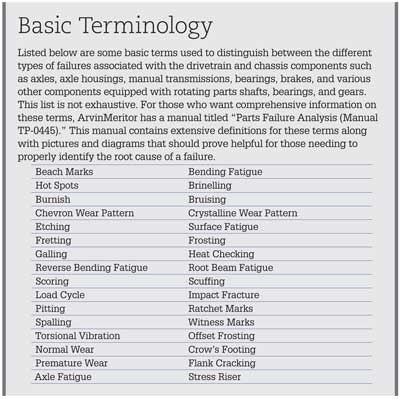 |
Christian P. Koop |
I think some failures are too easily relegated at face value to normal wear and tear when the actual problem may go much deeper. Departments should address why it failed. It can ultimately save the organization unnecessary equipment downtime and save big dollars at the same time. Additionally, it could lead to eventual equipment improvements industrywide.
Most in the ERV maintenance field should already have an adequate understanding of failure analysis and its importance. The main purpose behind this article is to discuss the basic failure analysis steps for those readers who may not be aware of them. I will also cover some of the common terminology associated with failure analysis and the steps involved in the process that departments sometimes do not follow correctly.
Underlying Problems
Finding out why a component or system failed catastrophically or had a shorter-than-normal service life is something that should be ingrained into a maintenance organization’s operations and its technicians. It should not matter whether the maintenance operation is private, municipal, or governmental. The curiosity alone of finding out the reason behind a failure-not just making repairs or replacing parts-will separate the average technicians from the good ones. In some cases, a design or manufacturing defect may actually be the culprit. On the other hand, it could be a training issue involving misuse of the equipment leading to early failure. Keep in mind that equipment misuse or improper operation by the driver/operator can lead to instant failures. Many times an ERV will continue to operate normally, but eventually the part or system affected will fail prematurely. It could also be that equipment was not specified or built for the level, severity of service, or even the climatic conditions of an ERV’s location.
The level of maintenance and the intervals may not be frequent enough or may not meet the basic minimum schedule recommended by the original equipment manufacturer (OEM). Keep in mind that most OEM-recommended maintenance schedules are minimum requirements and may need to be exceeded. The use of incorrect lubricants and fluids is another cause of failures and shortened service life. Yet another critical factor is operating ERVs beyond gross vehicle weight ratings (GVWRs), which will negatively impact entire drivetrain and chassis componentry service lives. Careful study and investigation of failures with the objective of finding the root cause will eventually point to one of the items mentioned above.
Don’t Assume
To properly begin failure analysis, you must take on the role of investigator and never assume that the failed part is the problem. Taking notes to document the process is very important and a basic requirement. Speaking to the driver, if possible, and asking the proper questions should also provide useful information. Many times a good visual inspection by an experienced technician can quickly find the cause. However, in some cases, it may be difficult to find and may require consultation with the OEM or the parts manufacturer or even using specialized equipment.
Determining whether a part failed over time or experienced a one-time catastrophic failure is very important in failure analysis. Depending on what parts failed, do not clean them before the inspection, and leave them on the vehicle. For example, if a wheel bearing was damaged by corrosion or lack of lubrication caused by water, washing the bearing before inspection may eliminate telltale signs that water had contaminated the grease, thus leading to the failure. The color of the grease alone will indicate if moisture or water contaminated it.
Wheel bearings will not have an adequate service life if emergency vehicle technicians (EVTs) do not torque them to specifications when servicing or replacing them. Either over- or undertorqueing the wheel bearings will lead to early failure. Using incorrect grease or oil will also lead to shortened service life. As previously mentioned, water contamination will lead to bearing failures and generally results from driving through deep water that goes over the wheel bearings. If operators don’t discover contamination early, the bearing surfaces will become pitted, likely resulting in bearing failure.
Brakes that are running beyond normal operating temperatures will also deplete the wheel bearing lubricant of important extreme-pressure additives that will eventually damage the bearings. If the temperatures are too severe, the lubricant will actually liquefy. The resulting lack of lubrication can cause the bearings to overheat, melt, and fuse to the spindle. If the driver does not notice anything wrong during operation in an extreme case such as this, the wheel end could come off, possibly resulting in a vehicular accident. The main point here is that employing failure analysis properly will determine what can cause or has caused the bearings to fail.
Ask Questions
A thorough failure analysis will always include a variety of questions to identify the cause or causes of failure. Some questions include the following:
- Was the vehicle overloaded?
- Had the vehicle been recently repaired?
- If several components failed, what part failed first?
- If an axle or drivetrain component failed, what was the torque rating?
- Was the vehicle involved in an accident?
- What were the weather conditions?
A vehicle’s age, in-service date, mileage, engine hours, and fuel consumption are other important elements that investigators must consider and document. If this is a fleet vehicle, how does it compare to the rest of the fleet in terms of service life and failed component life? Investigators will have to review maintenance records to compare sister ships and verify that EVTs are using the correct types of lubricants.
All ERV Systems
Fire departments can apply failure analysis to all modern ERV systems-not just the drivetrain and chassis components. This includes electronics, lighting systems, fire pumps, hydraulic systems, aerial ladders, and a host of other systems and accessories found on ERVs. Finding the root cause of failure and correcting it will not only help the organization for reasons mentioned above, but it could also lead to improvements in the industry and save lives as well. This can ultimately lead to safer and more reliable ERVs if departments share findings with the appropriate OEMs.
I like to compare it to automotive racing, where the process of continual improvements over the years has made race cars not only more reliable but also safer. As most know, improvements in the various types and classes of automobile racing have translated to safer and more reliable passenger cars. The same has occurred with ERVs to a degree. However, it takes all involved in ERV repair and maintenance to follow the process properly and document and share their findings to make a positive impact.
CHRISTIAN P. KOOP is the fleet manager for the Miami-Dade (FL) Fire Department. He has been involved in the repair and maintenance of autos, heavy equipment, and emergency response vehicles for the past 35 years. He has an associate degree from Central Texas College and a bachelor’s degree in public administration from Barry University and has taken course work in basic and digital electronics. He is an ASE-certified master auto/heavy truck technician and master EVT apparatus and ambulance technician. He is a member of the board of directors of EVTCC and FAEVT and a technical committee member for NFPA 1071, Standard for Emergency Vehicle Technician Professional Qualifications.


